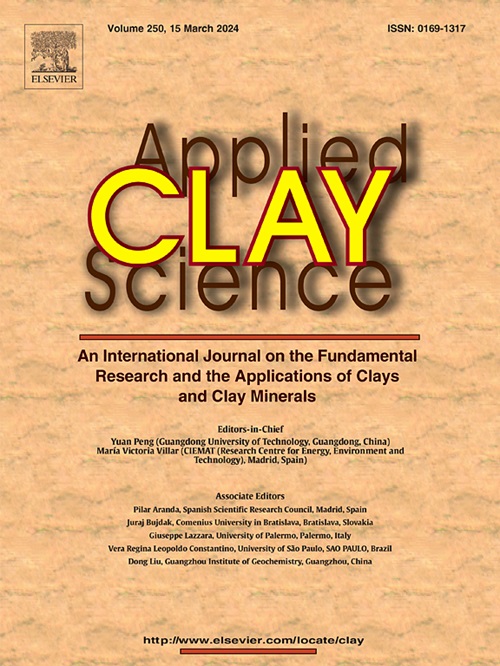Pillared interlayered clays in adsorption and advanced oxidation processes: A sustainable approach for green chemistry
IF 5.3
2区 地球科学
Q2 CHEMISTRY, PHYSICAL
引用次数: 0
Abstract
The Pillared Interlayered Clays (PILCs) are becoming increasingly popular for treating refractory wastewater effluents because of their many uses as adsorbents and catalysts, especially in advanced oxidation processes (AOPs). The review starts by outlining the fundamental idea of PILCs, its synthesis and enhancement in surface area and structural stability. This review emphasizes the use of PILCs and their role as active solid materials in adsorption and AOPs, such as photocatalysis, the Fenton process, catalytic wet peroxide oxidation (CWPO), and catalytic wet air oxidation (CWAO) of refractory organic compounds in contaminated aqueous streams. Aligned with green chemistry, PILCs offer a sustainable solution, with photocatalysis effective for low pollutant concentrations and CWPO, Fenton, and CWAO suited for higher concentrations. Utilizing UV and visible light, the PILCs-based AOPs effectively treats industrial wastewater by eliminating pollutants, reducing toxicity, and enhancing biodegradability. This study thoroughly summarizes the recent studies on PILCs and emphasizes their potential as valuable substances for catalytic removal processes and pollutant adsorption. Their adjustable porosity and acidity enable efficient, low-toxicity reactions. More research and development work is needed to realize the green potential of PILCs fully and enable their industrial and practical uses in a range of industries.
柱状夹层粘土在吸附和高级氧化过程中的应用:绿色化学的可持续发展途径
柱状夹层粘土(PILCs)因其作为吸附剂和催化剂的多种用途,特别是在高级氧化过程(AOPs)中,越来越受到难降解废水处理的欢迎。本文首先概述了复合材料的基本概念、复合材料的合成及其在表面积和结构稳定性方面的改进。本文综述了PILCs作为活性固体材料在光催化、Fenton工艺、催化湿式过氧化氧化(CWPO)和催化湿式空气氧化(CWAO)等难降解有机化合物的吸附和AOPs中的作用。与绿色化学相一致,PILCs提供了一种可持续的解决方案,光催化对低浓度污染物有效,而CWPO、Fenton和CWAO适用于高浓度污染物。利用紫外线和可见光,基于pilcs的AOPs通过去除污染物、降低毒性和提高生物降解性来有效地处理工业废水。本研究全面总结了近年来关于多聚物的研究,强调了它们作为催化去除工艺和污染物吸附的有价值物质的潜力。其可调节的孔隙度和酸度使高效,低毒性的反应。要充分发挥PILCs的绿色潜力,使其在各行各业实现工业化和实用化,还需要进行更多的研究和开发工作。
本文章由计算机程序翻译,如有差异,请以英文原文为准。
求助全文
约1分钟内获得全文
求助全文
来源期刊

Applied Clay Science
地学-矿物学
CiteScore
10.30
自引率
10.70%
发文量
289
审稿时长
39 days
期刊介绍:
Applied Clay Science aims to be an international journal attracting high quality scientific papers on clays and clay minerals, including research papers, reviews, and technical notes. The journal covers typical subjects of Fundamental and Applied Clay Science such as:
• Synthesis and purification
• Structural, crystallographic and mineralogical properties of clays and clay minerals
• Thermal properties of clays and clay minerals
• Physico-chemical properties including i) surface and interface properties; ii) thermodynamic properties; iii) mechanical properties
• Interaction with water, with polar and apolar molecules
• Colloidal properties and rheology
• Adsorption, Intercalation, Ionic exchange
• Genesis and deposits of clay minerals
• Geology and geochemistry of clays
• Modification of clays and clay minerals properties by thermal and physical treatments
• Modification by chemical treatments with organic and inorganic molecules(organoclays, pillared clays)
• Modification by biological microorganisms. etc...
 求助内容:
求助内容: 应助结果提醒方式:
应助结果提醒方式:


